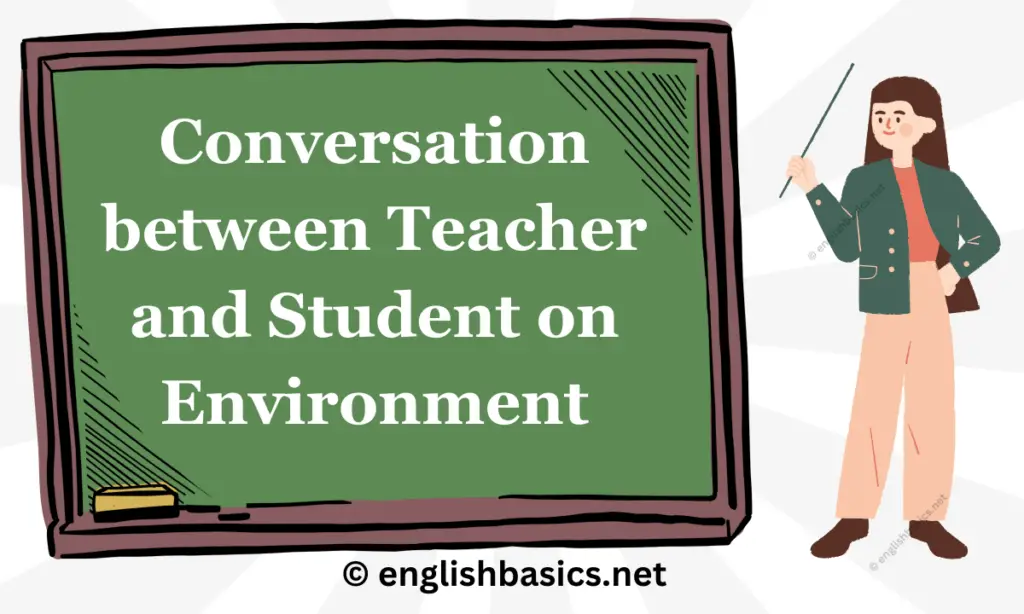This blog looks at a teacher and student conversation on the environment.

Sample Conversation between Teacher and Student on Environment – 1
Teacher: Good morning, class; today, We will discuss the environment and the importance of taking care of it. Can anyone tell me what the environment is?
Student: The environment is everything around us, including the air, water, and land.
Teacher: That’s correct. And what are some ways that we can take care of the environment?
Student: We can reduce, reuse, and recycle. We can also use renewable energy sources and plant trees.
Teacher: Exactly. Those are all great ways to help protect the environment. Can anyone give an example of how reducing, reusing, and recycling can make a difference?
Student: By recycling paper, we can save trees and reduce the pollution caused by making new paper.
Teacher: Excellent. And what are some examples of renewable energy sources?
Student: Solar, wind, and hydropower.
Teacher: That’s right. And what are the benefits of using renewable energy sources?
Student: They are more sustainable and don’t contribute to pollution, and greenhouse gases like fossil fuels do.
Teacher: Very well said. Remember, as individuals, we can make a difference in protecting the environment. Let’s all do our part by being mindful of our actions and making better environmental choices.
Student: Yes, let’s do our part to protect the planet for future generations.
Sample Conversation between Teacher and Student on Environment – 2
Teacher: Alright, class, today we are going to talk about the effects of pollution on the environment. Can anyone tell me what pollution is?
Student: Pollution is the presence or introduction into the environment of a substance or thing that has harmful or poisonous effects.
Teacher: Perfect definition. Can you give an example of pollution?
Student: Air pollution from factories, cars, and power plants.
Teacher: That’s one example. What are some other types of pollution?
Student: Water pollution from oil spills, chemical waste, and plastic pollution in the oceans.
Teacher: Excellent. And what are some of the effects of pollution on the environment and living organisms?
Student: Air pollution can cause respiratory problems, water pollution can make fish and other aquatic life sick or die, and plastic pollution can harm marine animals and birds.
Teacher: Yes, pollution can have serious consequences. Can anyone suggest ways to reduce pollution?
Student: We can use public transportation or carpool instead of driving alone, recycle, and use products that are not harmful to the environment.
Teacher: Exactly. And remember, it’s not just about individuals making changes. We need to work together as a society to reduce pollution and protect the environment.
Student: Yes, we should also advocate for laws and regulations to protect the environment and hold companies accountable for their pollution.
Teacher: Exactly, good point. We must take action and make a difference for the environment, for our own health, and for future generations.
Sample Conversation between Teacher and Student on Environment – 3
Teacher: Good afternoon, class. Today we will be discussing the importance of preserving biodiversity. Can anyone tell me what biodiversity is?
Student: Biodiversity is the variety of life in a particular ecosystem or on the entire planet.
Teacher: Very good. Can you give an example of biodiversity?
Student: A rainforest is an excellent example of biodiversity because it has many different species of plants and animals living in it.
Teacher: That’s right. And what are some of the benefits of biodiversity?
Student: Biodiversity helps to maintain the balance of ecosystems, it’s important for medicine and food, and it also helps to protect against climate change.
Teacher: Exactly. Can anyone give an example of how human activities have affected biodiversity?
Student: Deforestation and habitat destruction for agriculture and urbanization are some examples.
Teacher: Yes, human activities can have a negative impact on biodiversity. What can we do to preserve biodiversity?
Student: We can protect endangered species, conserve natural habitats and ecosystems, and promote sustainable practices in agriculture and industry.
Teacher: Perfect. And remember, preserving biodiversity is essential for the survival of many species, including our own, and for the planet’s health.
Student: Yes, we should take action to protect biodiversity before it’s too late and ensure a sustainable future for all living organisms.